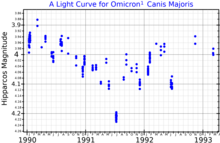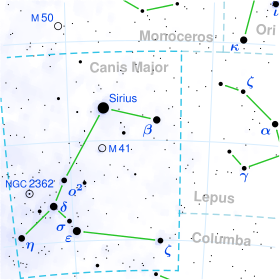Omicron1 Canis Majoris
| Observation data Epoch J2000 Equinox J2000 | |
|---|---|
| Constellation | Canis Major |
| Right ascension | 06h 54m 07.9523s[1] |
| Declination | −24° 11′ 03.160″[1] |
| Apparent magnitude (V) | 3.87[2] (3.78 - 3.99[3]) |
| Characteristics | |
| Evolutionary stage | Red supergiant |
| Spectral type | K2.5 Iab[4] |
| U−B color index | +1.99[2] |
| B−V color index | +1.73[2] |
| Variable type | Slow irregular variable (Lc)[3] |
| Astrometry | |
| Radial velocity (Rv) | +36.3[5] km/s |
| Proper motion (μ) | RA: −3.771 mas/yr[1] Dec.: 4.503 mas/yr[1] |
| Parallax (π) | 1.2869 ± 0.1209 mas[1] |
| Distance | 2673±241 ly (820±74 pc)[6] |
| Absolute magnitude (MV) | −4.69[4] |
| Details | |
| Mass | 7.83 ± 2.0[7] M☉ 14.38±2.88[8] M☉ 18[9] M☉ |
| Radius | 390[10] R☉ |
| Luminosity | 37,414[10] L☉ |
| Temperature | 4,015[10] K |
| Metallicity [Fe/H] | −0.11[11] dex |
| Rotational velocity (v sin i) | 12.31[12] km/s |
| Age | 18[9] Myr |
| Other designations | |
| Database references | |
| SIMBAD | data |
Omicron1 Canis Majoris (ο1 CMa, ο1 Canis Majoris) is a red supergiant star in the constellation Canis Major. It is also a variable star.
Name
[edit]Johann Bayer gave two adjacent stars the Bayer designation of ο Canis Majoris in 1603, but without distinguishing between the stars. John Flamsteed gave the two omicron stars his own numbered designations of 16 and 24 Canis Majoris in the early 18th century.[13] Friedrich Wilhelm Argelander labelled the stars as ο1 and ο2 in his atlas Uranometria Nova.[14] Nicolas Louis de Lacaille labelled it c Canis Majoris, but this was not upheld by subsequent cartographers.[15] Its Henry Draper Catalogue designation is HD 50877. The two Omicron stars marked the centre of the Great Dog's body on Bayer's 1603 Uranometria.[16]
Distance
[edit]
The distance to ο1 Canis Majoris is uncertain. It is strongly associated with the Collinder 121 stellar association, located around 3,500 light years (1,085 parsecs) distant.[17] Its original Hipparcos parallax placed it at 610 pc, similar to the distance of EZ Canis Majoris, another member of Cr 121. ο1 CMa appears to be interacting with the nebula around EZ CMa, implying the two are at the same distance.[citation needed] However, the revised Hipparcos parallax is only 0.22 mas, with a large margin of error of 0.43 mas,[18] so the distance is not well-defined but likely to be large. The distance to EZ CMa is now thought to be around 1,500 pc.[19] Conversely, though only separated by 2 degrees from the blue supergiant ο2 Canis Majoris, the two appear to be unrelated.[9]
Bailer-Jones et al. (2021) estimate a distance of 820 parsecs, give or take 74 parsecs to Omicron1 Canis Majoris, using a method that use its parallax from Gaia EDR3, its color and apparent magnitude.[6]
Description
[edit]
The star itself is an orange K-type supergiant of spectral type K2.5 Iab and is an irregular variable star, varying between apparent magnitudes 3.78 and 3.99. A cool star, its surface temperature is around 4,000 K.[10] Around 8 times as massive as the Sun[7] with around 390 times its diameter, it shines with 37,000 times its luminosity.[10] Interstellar dust only obscures it slightly, and its apparent magnitude is 0.16 fainter than it would be if unobscured.[4] Thought to be around 18 million years old, ο1 Canis Majoris is undergoing nuclear fusion of helium in its core to generate energy and will one day explode as a type II supernova.[9]
References
[edit]- ^ a b c d Vallenari, A.; et al. (Gaia collaboration) (2023). "Gaia Data Release 3. Summary of the content and survey properties". Astronomy and Astrophysics. 674: A1. arXiv:2208.00211. Bibcode:2023A&A...674A...1G. doi:10.1051/0004-6361/202243940. S2CID 244398875. Gaia DR3 record for this source at VizieR.
- ^ a b c Ducati, J. R. (2002). "VizieR Online Data Catalog: Catalogue of Stellar Photometry in Johnson's 11-color system". CDS/ADC Collection of Electronic Catalogues. 2237. Bibcode:2002yCat.2237....0D.
- ^ a b Samus, N. N.; Durlevich, O. V.; et al. (2009). "VizieR Online Data Catalog: General Catalogue of Variable Stars (Samus+ 2007-2013)". VizieR On-line Data Catalog: B/GCVS. Originally Published in: 2009yCat....102025S. 1. Bibcode:2009yCat....102025S.
- ^ a b c Levesque, E. M.; Massey, P.; Olsen, K. A. G.; Plez, B.; Josselin, E.; Maeder, A.; Meynet, G. (2005). "The Effective Temperature Scale of Galactic Red Supergiants: Cool, but Not as Cool as We Thought". The Astrophysical Journal. 628 (2): 973–985. arXiv:astro-ph/0504337. Bibcode:2005ApJ...628..973L. doi:10.1086/430901. S2CID 15109583.
- ^ Evans, D. S. (1967). "The Revision of the General Catalogue of Radial Velocities". Determination of Radial Velocities and Their Applications. 30: 57. Bibcode:1967IAUS...30...57E.
- ^ a b Bailer-Jones, C. A. L.; Rybizki, J.; Fouesneau, M.; Demleitner, M.; Andrae, R. (2021). "Estimating Distances from Parallaxes. V. Geometric and Photogeometric Distances to 1.47 Billion Stars in Gaia Early Data Release 3". The Astronomical Journal. 161 (3): 147. arXiv:2012.05220. Bibcode:2021AJ....161..147B. doi:10.3847/1538-3881/abd806. S2CID 228063812. Data about this star can be seen here.
- ^ a b Reffert, Sabine; Bergmann, Christoph; Quirrenbach, Andreas; Trifonov, Trifon; Künstler, Andreas (2015). "Precise radial velocities of giant stars. VII. Occurrence rate of giant extrasolar planets as a function of mass and metallicity". Astronomy & Astrophysics. 574: A116. arXiv:1412.4634. Bibcode:2015A&A...574A.116R. doi:10.1051/0004-6361/201322360. hdl:10722/215277. S2CID 59334290.
- ^ Kervella, Pierre; Arenou, Frédéric; Thévenin, Frédéric (2022-01-01). "Stellar and substellar companions from Gaia EDR3. Proper-motion anomaly and resolved common proper-motion pairs". Astronomy and Astrophysics. 657: A7. arXiv:2109.10912. Bibcode:2022A&A...657A...7K. doi:10.1051/0004-6361/202142146. ISSN 0004-6361. o1 Canis Majoris' database entry at VizieR.
- ^ a b c d Kaler, James B. "Omicron1 Canis Majoris". Stars. University of Illinois. Retrieved 24 February 2014.
- ^ a b c d e Healy, Sarah; Horiuchi, Shunsaku; Molla, Marta Colomer; Milisavljevic, Dan; Tseng, Jeff; Bergin, Faith; Weil, Kathryn; Tanaka, Masaomi (2024-03-23). "Red Supergiant Candidates for Multimessenger Monitoring of the Next Galactic Supernova". Monthly Notices of the Royal Astronomical Society. 529 (4): 3630–3650. arXiv:2307.08785. doi:10.1093/mnras/stae738. ISSN 0035-8711.
- ^ Marrese, P. M.; Boschi, F.; Munari, U. (2003). "High resolution spectroscopy over lambda lambda 8500-8750 Å for GAIA. IV. Extending the cool MK stars sample". Astronomy and Astrophysics. 406 (3): 995. Bibcode:2003A&A...406..995M. doi:10.1051/0004-6361:20030647.
- ^ Hekker, S.; Meléndez, J. (2007). "Precise radial velocities of giant stars". Astronomy and Astrophysics. 475 (3): 1003. arXiv:0709.1145. Bibcode:2007A&A...475.1003H. doi:10.1051/0004-6361:20078233. S2CID 10436552.
- ^ John Flamsteed; Claudius Ptolemaeus; Tycho Brahe; Johannes Hevelius; Abraham Sharp (1725). Historia Coelestis Britannica: Complectens Praefationem spatiosam (sive in Stellarum Fixarum Catalogum Prolegomena) quae brevem Astronomiae Historiam praebet, atque Descriptionem Observationum peractarum, & Organorum adhibitorum tum a pristinis Astronomis, tum In Observatorio Regio Grenovicensi; Deinceps Fixarum Catalogum a Ptolemaeo, Uleg Beig, Tychone Brahaeo, Gulielmo Hessiae Landtgravio, ac Hevelio constructum ...: Quibus adnexus est Fixarum quarundam Australium Catalogus, in nostro Hemisphaerio non adspectabilium, Denique Tabulae …. Meere. pp. 2–.
- ^ Argelander, Friedrich Wilhelm August (1843). "Uranometria nova: stellae per mediam europam solis oculis conspicuae secundum veras lucis magnitudines e coelo ipso descriptae = Neue Uranometrie: Darstellung der im mittlern Europa mit blossen Augen sichtbaren Sterne nach ihren wahren, unmittelbar vom Himmel entnommenen Grössen / Fr. Argelander". Uranometria Nova: Stellae per Mediam Europam Solis Oculis Conspicuae Secundum Veras Lucis Magnitudines e Coelo Ipso Descriptae = Neue Uranometrie: Darstellung der Im Mittlern Europa mit Blossen Augen Sichtbaren Sterne Nach Ihren Wahren. Schropp. Bibcode:1843urno.book.....A. doi:10.3931/e-rara-559.
- ^ Wagman, Morton (2003). Lost Stars: Lost, Missing and Troublesome Stars from the Catalogues of Johannes Bayer, Nicholas Louis de Lacaille, John Flamsteed, and Sundry Others. Blacksburg, VA: The McDonald & Woodward Publishing Company. pp. 73–74. ISBN 978-0-939923-78-6.
- ^ Wagman, p. 504.
- ^ Kaltcheva, N. T. (2000). "The region of Collinder 121". Monthly Notices of the Royal Astronomical Society. 318 (4): 1023–35. Bibcode:2000MNRAS.318.1023K. doi:10.1046/j.1365-8711.2000.03689.x.
- ^ Van Leeuwen, F. (2007). "Validation of the new Hipparcos reduction". Astronomy and Astrophysics. 474 (2): 653–664. arXiv:0708.1752. Bibcode:2007A&A...474..653V. doi:10.1051/0004-6361:20078357. S2CID 18759600.
- ^ Toalá, J. A.; Guerrero, M. A.; Ramos-Larios, G.; Guzmán, V. (2015). "WISE morphological study of Wolf-Rayet nebulae". Astronomy & Astrophysics. 578: A66. arXiv:1503.06878. Bibcode:2015A&A...578A..66T. doi:10.1051/0004-6361/201525706. ISSN 0004-6361. S2CID 55776698.
- ^ "Hipparcos Tools Interactive Data Access". Hipparcos. ESA. Retrieved 8 December 2021.

